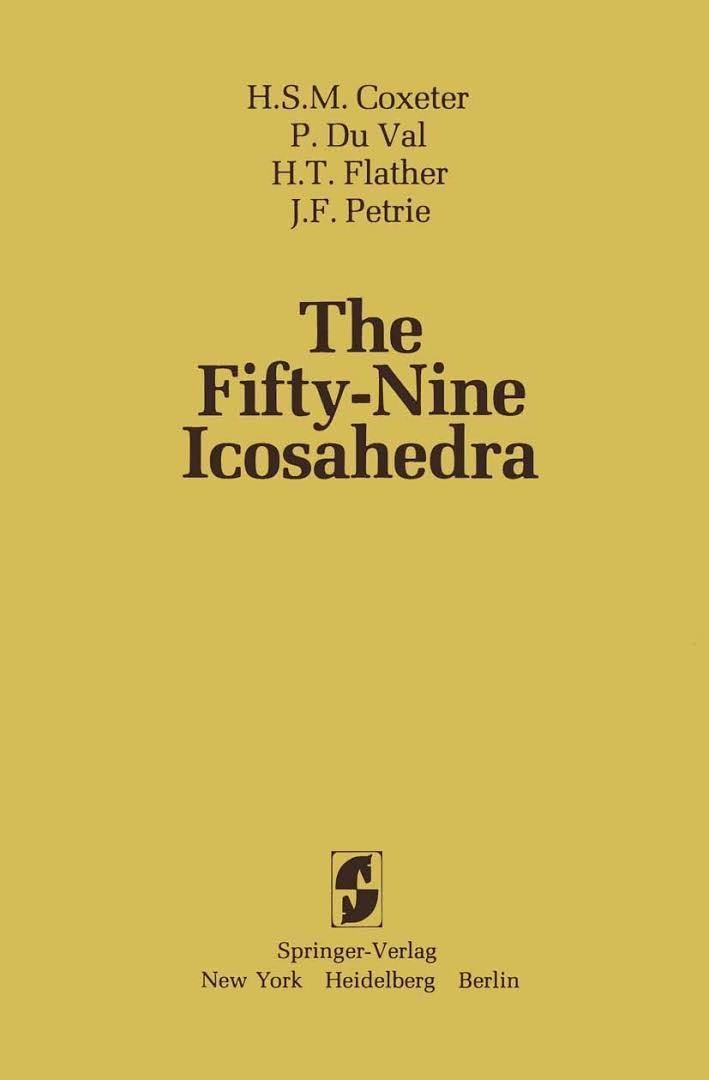9.4 /10 1 Votes9.4
Originally published 1938 | 4.7/5 Goodreads | |||||||||||||||||||||||||||||||||
 | ||||||||||||||||||||||||||||||||||
Similar Works by Harold Scott MacDonald Coxeter, Geometry books | ||||||||||||||||||||||||||||||||||
The Fifty-Nine Icosahedra is a book written and illustrated by H. S. M. Coxeter, P. Du Val, H. T. Flather and J. F. Petrie. It enumerates certain stellations of the regular convex or Platonic icosahedron, according to a set of rules put forward by J. C. P. Miller.
Contents
- Millers rules
- Coxeter
- Du Val
- Flather
- Petrie
- The Crennells
- List of the fifty nine icosahedra
- Notes on the list
- References
First published by the University of Toronto in 1938, a Second Edition by Springer-Verlag followed in 1982. K. and D. Crennell completely reset the text and redrew the plates and diagrams for Tarquin's 1999 Third Edition, also adding new reference material and photographs.
Miller's rules
Although Miller did not contribute to the book directly, he was a close colleague of Coxeter and Petrie. His contribution is immortalised in his set of rules for defining which stellation forms should be considered "properly significant and distinct":
(i) The faces must lie in twenty planes, viz., the bounding planes of the regular icosahedron.(ii) All parts composing the faces must be the same in each plane, although they may be quite disconnected.(iii) The parts included in any one plane must have trigonal symmetry, without or with reflection. This secures icosahedral symmetry for the whole solid.(iv) The parts included in any plane must all be "accessible" in the completed solid (i.e. they must be on the "outside". In certain cases we should require models of enormous size in order to see all the outside. With a model of ordinary size, some parts of the "outside" could only be explored by a crawling insect).(v) We exclude from consideration cases where the parts can be divided into two sets, each giving a solid with as much symmetry as the whole figure. But we allow the combination of an enantiomorphous pair having no common part (which actually occurs in just one case).Rules (i) to (iii) are symmetry requirements for the face planes. Rule (iv) excludes buried holes, to ensure that no two stellations look outwardly identical. Rule (v) prevents any disconnected compound of simpler stellations.
Coxeter
Coxeter was the main driving force behind the work. He carried out the original analysis based on Miller's rules, adopting a number of techniques such as combinatorics and abstract graph theory whose use in a geometrical context was then novel.
He observed that the stellation diagram comprised many line segments. He then developed procedures for manipulating combinations of the adjacent plane regions, to formally enumerate the combinations allowed under Miller's rules.
His graph, reproduced here, shows the connectivity of the various faces identified in the stellation diagram (see below). The Greek symbols represent sets of possible alternatives:
λ may be 3 or 4μ may be 7 or 8ν may be 11 or 12Du Val
Du Val devised a symbolic notation for identifying sets of congruent cells, based on the observation that they lie in "shells" around the original icosahedron. Based on this he tested all possible combinations against Miller's rules, confirming the result of Coxeter's more analytical approach.
Flather
Flather's contribution was indirect: he made card models of all 59. When he first met Coxeter he had already made many stellations, including some "non-Miller" examples. He went on to complete the series of fifty-nine, which are preserved in the mathematics library of Cambridge University, England. The library also holds some non-Miller models, but it is not known whether these were made by Flather or by Miller's later students.
Petrie
John Flinders Petrie was a lifelong friend of Coxeter and had a remarkable ability to visualise four-dimensional geometry. He and Coxeter had worked together on many mathematical problems. His direct contribution to the fifty nine icosahedra was the exquisite set of three-dimensional drawings which provide much of the fascination of the published work.
The Crennells
For the Third Edition, Kate and David Crennell completely reset the text and redrew the illustrations and Plates. They also added a reference section containing tables, diagrams, and photographs of some of the Cambridge models (which at that time were all thought to be Flather's). It includes an index of all 59, numbered sequentially as they appear in the book. A few errors crept into the editing process, such as in some of the Plates and in the annotations to Fig.7. A PDF file of corrected pages is available online.
List of the fifty nine icosahedra
Before Coxeter, only Brückner and Wheeler had recorded any significant sets of stellations, although a few such as the great icosahedron had been known for longer. Since publication of The 59, Wenninger published instructions on making models of some; the numbering scheme used in his book has become widely referenced, although he only recorded a few stellations.
Notes on the list
Index numbers are the Crennells' unless otherwise stated:
Crennell
VRML
Cells
Faces
Wenninger
Wheeler
Brückner
Remarks
